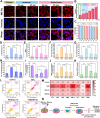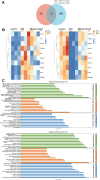A multifunctional "three-in-one" fluorescent theranostic system for hepatic ischemia-reperfusion injury
- PMID: 39568886
- PMCID: PMC11575585
- DOI: 10.1039/d4sc04962d
A multifunctional "three-in-one" fluorescent theranostic system for hepatic ischemia-reperfusion injury
Abstract
Hepatic ischemia-reperfusion injury (HIRI) is the main cause of postoperative liver dysfunction and liver failure. Traditional separation of HIRI diagnosis and therapy confers several disadvantages, including the inability to visualize the therapeutic and asynchronous action. However, developing a versatile material with integrated diagnosis and treatment for HIRI remains a great challenge. Given that hypochlorous acid (HOCl) plays a crucial oxidative role in HIRI, we developed a single-component multifunctional fluorescent theranostic platform (MB-Gly) with a "three-in-one" molecular design incorporating a near-infrared fluorophore methylene blue, glycine and a HOCl-response unit, which could not only provide real-time visualization of HIRI but also boost targeted drug delivery. Using MB-Gly, we were able to achieve real-time and dynamic monitoring of HOCl during HIRI in hepatocytes and mouse livers and reduce the liver damage in hepatocytes and mice. RNA sequencing illustrated the therapeutic role of MB-Gly associated with changes in gene expression related to apoptosis, oxidative stress, metabolism and inflammation. To the best of our knowledge, this is the first multifunctional fluorescent theranostic system for HIRI reported to date. Our smart "three-in-one" approach shines light on the etiology and pathogenesis of HIRI, providing profound insights into the development of potential therapeutic targets.
This journal is © The Royal Society of Chemistry.
Conflict of interest statement
There are no conflicts to declare.
Figures






Similar articles
-
Unveiling the Crucial Roles of O2•- and ATP in Hepatic Ischemia-Reperfusion Injury Using Dual-Color/Reversible Fluorescence Imaging.J Am Chem Soc. 2023 Sep 13;145(36):19662-19675. doi: 10.1021/jacs.3c04303. Epub 2023 Sep 1. J Am Chem Soc. 2023. PMID: 37655757 Free PMC article.
-
Remimazolam alleviates hepatic ischemia-reperfusion injury by activating FOXO1/3 signaling : Remimazolam alleviates hepatic ischemia reperfusion injury.BMC Gastroenterol. 2025 Apr 22;25(1):283. doi: 10.1186/s12876-025-03820-3. BMC Gastroenterol. 2025. PMID: 40263992 Free PMC article.
-
Remifentanil represses oxidative stress to relieve hepatic ischemia/reperfusion injury via regulating BACH1/PRDX1 axis.Clin Res Hepatol Gastroenterol. 2024 Oct;48(8):102422. doi: 10.1016/j.clinre.2024.102422. Epub 2024 Jul 16. Clin Res Hepatol Gastroenterol. 2024. PMID: 39025461
-
Reversible Fluorescent Probes for Dynamic Imaging of Liver Ischemia-Reperfusion Injury.Acc Chem Res. 2024 Sep 3;57(17):2594-2605. doi: 10.1021/acs.accounts.4c00449. Epub 2024 Aug 20. Acc Chem Res. 2024. PMID: 39164205 Review.
-
Targeting NF-κB in Hepatic Ischemia-Reperfusion Alleviation: from Signaling Networks to Therapeutic Targeting.Mol Neurobiol. 2024 Jun;61(6):3409-3426. doi: 10.1007/s12035-023-03787-w. Epub 2023 Nov 22. Mol Neurobiol. 2024. PMID: 37991700 Review.
References
LinkOut - more resources
Full Text Sources
Miscellaneous

